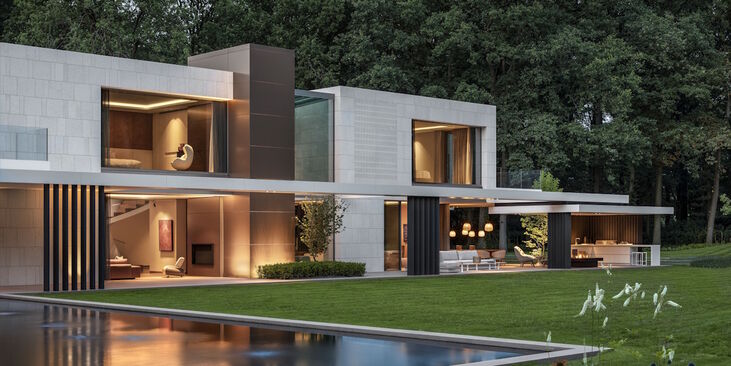17. Mar 2021
View from America: early adoption of KNX is more risk-free than you think

Philip Juneau discusses the unifying nature KNX-based building control and how to change mindsets in order to hasten its adoption in the USA.
I recently participated in a CEDIA podcast on awareness of KNX and its adoption in America. It was not scripted and was open to spontaneous Qimport_contentamp;As. During the dialogue, it became crystal clear that, above all else, KNX is a unifying platform. It really has no boundaries when it comes to combining multiple building applications, especially at field or occupant control level (e.g., room switches, presence sensors, graphical interfaces, etc.) At its inception, KNX was created to allow building control components from different manufacturers to communicate via one common language. Its open and unifying precedence was established; this is the pure, core strength of KNX.
KNX was initially designed and developed for lighting control, however it naturally evolved to include other building trade applications such as daylighting, HVAC, security and A/V. There is no other protocol or platform that has seen manufacturing competitors cooperate in this way, to open their product offering and create a level playing field. The result after 30 years of market implementation is a focus on integrating building applications in a unified system, eliminating complexity and technical barriers and allowing installers and integrators to focus on the customer's requirements.
Getting your house in order
The first step in unifying your building applications is to understand which of them requires integrated control. In other words, you need to get your house in order! If you can combine your lighting and HVAC control for example, the savings in both installation and operating costs can be substantial. In fact we can take a leaf out of our European colleagues' book, where the European Norm EN 15232 provides efficiency classes based on the types of controls employed in the building, for market reference and benchmarking purposes.
KNX is clearly the platform to allow true and extensive interoperability of the building trade systems, streamlined to allow for efficiency in design, implementation, operation and maintenance. This is proven worldwide, and the USA can benefit tremendously from the experience and knowledge attained over the last 30 years; there is no need to reinvent the wheel - we have a Maserati already available.
Distributed versus centralised control
In the building automation and controls sector, a centralised approach is typically adopted, with logic down to the controller level, which monitors and controls the various analogue and digital inputs and outputs of sensing and operating devices. The ‘brains' of it all resides in the central controller that is usually located in a panel far away from the end control devices. The end devices require separate power and communication cabling, which add to the installation and commissioning costs. If the controller becomes inoperable, the end-devices will only be able to run in autonomous/local mode, which results in inefficiency and a lack of control. This makes troubleshooting time-consuming and inefficient.
Last but not least, centralised control diagnostics, commissioning, and maintenance are more conducive to central plant applications, given the dynamic variables required for this type of control.
KNX, on the other hand, is based on the principle of decentralised control. This means that the ‘brains' does not reside in a central controller, but is distributed across all of the end-devices, such as wall switches, presence sensors, electronic actuators for lighting/shading, etc. So, if one or more end devices fail, the system continues to operate, and identifies the individual component failures for ease of both troubleshooting and resolution. Sounds too good to be true? Well, all you have to do is talk to any KNX professional and they will confirm this and more besides, with myriad examples of successful and reliable installations.
Indeed decentralised control has many benefits for room/zone control, including streamlining installation, troubleshooting and overall operation. Distributed, local control provides a robust structure/architecture, making installation, commissioning and operation of individual components straightforward. The bus communication topology used by KNX means that a single twisted-pair cable transports data and power to all connected devices, simplifying cabling, and making addition or replacement easy. It is also worth noting that KNX can work wirelessly over RF, and it uses one software commissioning tool, thereby simplifying training too.
Adoption in the USA is a slow but steady process
Adoption of KNX here in the USA has been very slow for various reasons, ranging from the ‘not-invented-here' syndrome right up to protectionism of regionally-focused manufacturers. That said, from the last few years of being back in the States, I have learned that being open to change is a question of mindset. One can have the most compelling arguments, justified right down to the technical level, but if someone is of the ‘If it ain't broke, don't fix it' mentality, it's a challenge to change their view. Well, it may not be broken, but it sure isn't what it should or could be - advanced, streamlined and easy to use!
KNX is a global standard for intelligent building control, fit for the demands of the 21st century. It is forward-looking, yet backwardly compatible, and will never leave you stranded - you can mix and match over 8000 KNX products from 500 manufacturers around the world, with the confidence that they will work seamlessly together and stand the test of time, so you will never be held hostage by a single supplier or systems integrator.
Our region has the ability to change its approach, as the risks are low and the benefits are many. We need to change our mindset to that of an ‘early adopter', so we can vet out the technology in a pragmatic way, eliminate all major concerns, and then benefit from its implementation. This is a simple, straightforward exercise; there are thousands of reference projects worldwide that will assure you of the flexibility, reliability and compatibility of KNX, and there are so many more exciting KNX projects and developments underway. Here is the opportunity to be a leader, a front-runner, in the building controls space, with the confidence that it is already a well-established and proven technology.
Summary
The KNX protocol is many things, but in simplistic terms, it's a unifying platform that provides streamlined, flexible and future-proof building technology controls aligned under one communication standard and one commissioning tool. If you want to reduce your risk and maximise your yield for any building or infrastructure project, look no further than KNX! Those early adopters in the rest of the world are now part of the mainstream, so why not join them? You will be in good company.
Philip R. Juneau is the Vice President of the KNX USA National Group and Advisor to Automated Technology Company. ATC's mission is to transform today's buildings into tomorrow's net-zero infrastructure by ensuring the highest levels of safety, comfort and efficiency for the overall well-being of its occupants and the overall environment.
Highlights
-
 News
NewsThe KNX Journal 2025 is now available
The latest edition of our annual smart home and building solutions magazine has arrived. The KNX Journal 2025 offers ... -
 News
NewsNew ETS App: Password Manager
The ETS Password Manager is a powerful new ETS App introduced in ETS 6.3 that eliminates the need to repeatedly enter ... -

